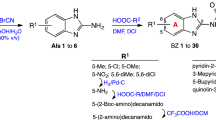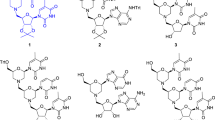Abstract
IN the evolution of the antimalarial drug ‘Paludrine’, the diguanide system was selected because it provided structural features similar to those found in the earlier active pyrimidine compound ‘2666’1. The biochemistry of the former drug, together with the results obtained in both experimental and clinical therapy, indicate, however, that it is biologically distinct from the prototype molecule. Thus, for example, therapeutic potency is many times greater, and is apparent not only against the erythrocytic but also against the exo-erythrocytic forms of the malaria parasite. Further, ‘Paludrine’ does not show the antagonism for riboflavine exhibited by ‘2666’ (and mepacrine) with respect to the growth of the Lactobacillus casei, an effect that we associate with the formal structural resemblance of the latter drugs to the vitamin, and which may also be connected with their parasiticidal activity.
This is a preview of subscription content, access via your institution
Access options
Subscribe to this journal
Receive 51 print issues and online access
$199.00 per year
only $3.90 per issue
Buy this article
- Purchase on Springer Link
- Instant access to full article PDF
Prices may be subject to local taxes which are calculated during checkout
Similar content being viewed by others
References
Curd, F. H. S., Davey, D. G., and Rose, F. L., Ann. Trop. Med. and Parasitol., 39, 208 (1945).
Author information
Authors and Affiliations
Rights and permissions
About this article
Cite this article
CURD, F., ROSE, F. A Possible Mode of Action of ‘Paludrine’. Nature 158, 707–708 (1946). https://doi.org/10.1038/158707b0
Issue Date:
DOI: https://doi.org/10.1038/158707b0
This article is cited by
-
Benziminazoles Related to Paludrine
Nature (1947)
Comments
By submitting a comment you agree to abide by our Terms and Community Guidelines. If you find something abusive or that does not comply with our terms or guidelines please flag it as inappropriate.



